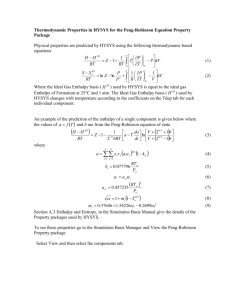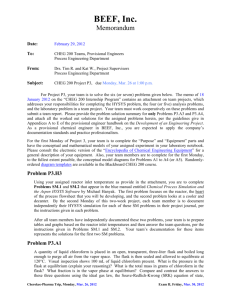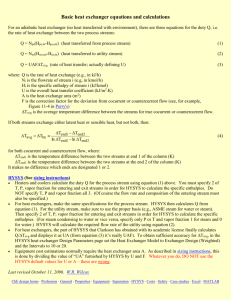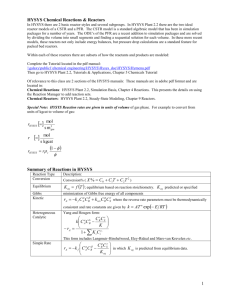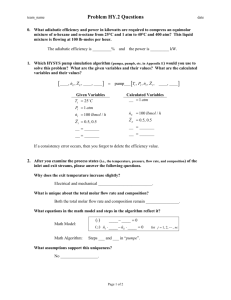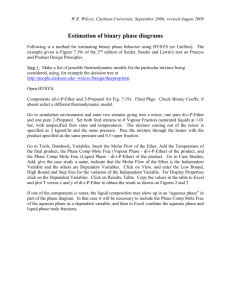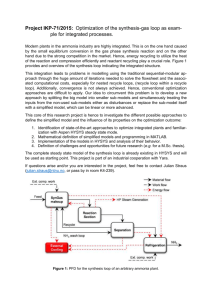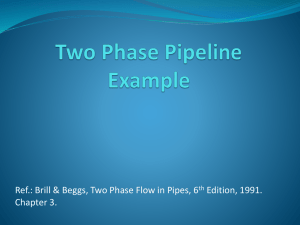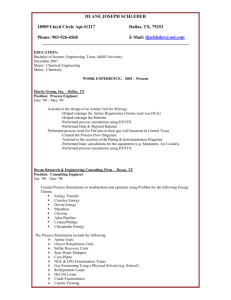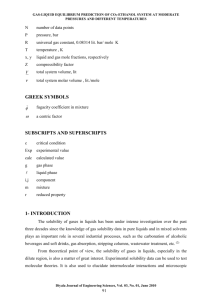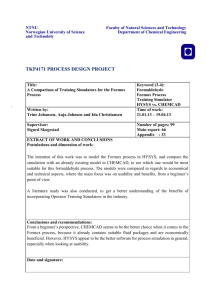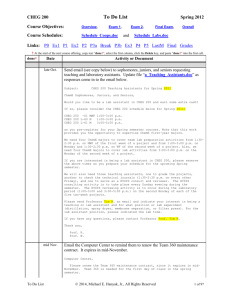Your sophomore team of four engineers must consult the HYSYS
advertisement
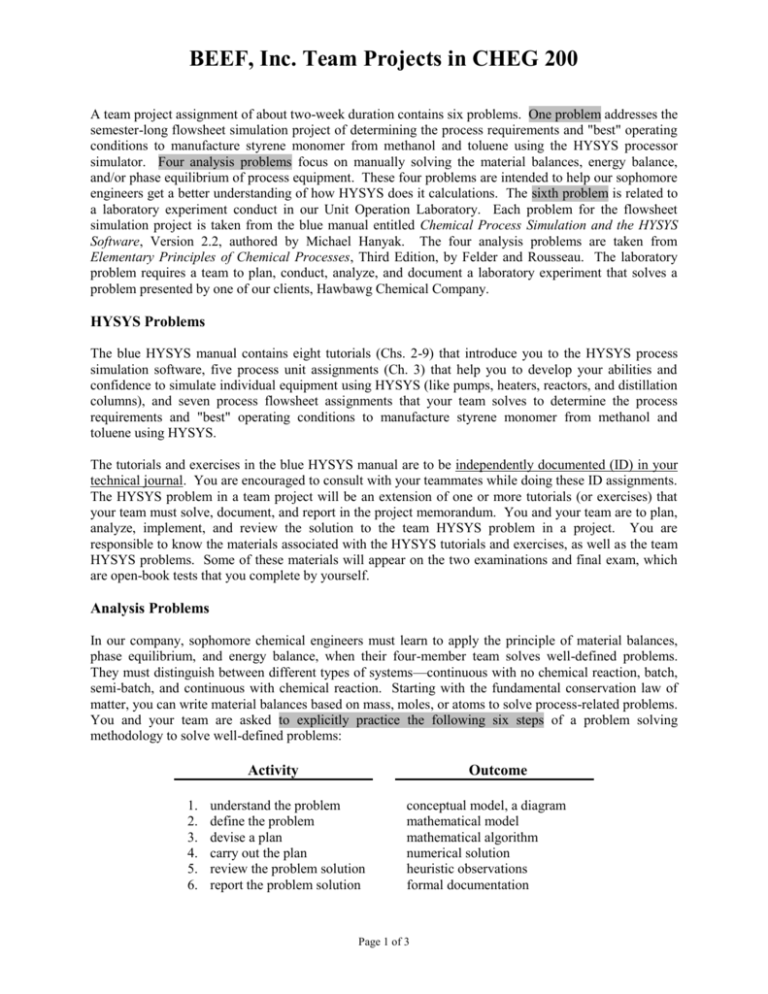
BEEF, Inc. Team Projects in CHEG 200 A team project assignment of about two-week duration contains six problems. One problem addresses the semester-long flowsheet simulation project of determining the process requirements and "best" operating conditions to manufacture styrene monomer from methanol and toluene using the HYSYS processor simulator. Four analysis problems focus on manually solving the material balances, energy balance, and/or phase equilibrium of process equipment. These four problems are intended to help our sophomore engineers get a better understanding of how HYSYS does it calculations. The sixth problem is related to a laboratory experiment conduct in our Unit Operation Laboratory. Each problem for the flowsheet simulation project is taken from the blue manual entitled Chemical Process Simulation and the HYSYS Software, Version 2.2, authored by Michael Hanyak. The four analysis problems are taken from Elementary Principles of Chemical Processes, Third Edition, by Felder and Rousseau. The laboratory problem requires a team to plan, conduct, analyze, and document a laboratory experiment that solves a problem presented by one of our clients, Hawbawg Chemical Company. HYSYS Problems The blue HYSYS manual contains eight tutorials (Chs. 2-9) that introduce you to the HYSYS process simulation software, five process unit assignments (Ch. 3) that help you to develop your abilities and confidence to simulate individual equipment using HYSYS (like pumps, heaters, reactors, and distillation columns), and seven process flowsheet assignments that your team solves to determine the process requirements and "best" operating conditions to manufacture styrene monomer from methanol and toluene using HYSYS. The tutorials and exercises in the blue HYSYS manual are to be independently documented (ID) in your technical journal. You are encouraged to consult with your teammates while doing these ID assignments. The HYSYS problem in a team project will be an extension of one or more tutorials (or exercises) that your team must solve, document, and report in the project memorandum. You and your team are to plan, analyze, implement, and review the solution to the team HYSYS problem in a project. You are responsible to know the materials associated with the HYSYS tutorials and exercises, as well as the team HYSYS problems. Some of these materials will appear on the two examinations and final exam, which are open-book tests that you complete by yourself. Analysis Problems In our company, sophomore chemical engineers must learn to apply the principle of material balances, phase equilibrium, and energy balance, when their four-member team solves well-defined problems. They must distinguish between different types of systems—continuous with no chemical reaction, batch, semi-batch, and continuous with chemical reaction. Starting with the fundamental conservation law of matter, you can write material balances based on mass, moles, or atoms to solve process-related problems. You and your team are asked to explicitly practice the following six steps of a problem solving methodology to solve well-defined problems: Activity 1. 2. 3. 4. 5. 6. Outcome understand the problem define the problem devise a plan carry out the plan review the problem solution report the problem solution conceptual model, a diagram mathematical model mathematical algorithm numerical solution heuristic observations formal documentation Page 1 of 3 BEEF, Inc. Team Projects in CHEG 200 This methodology provides a step-by-step structure that helps you and your team to reach the final goal, a single correct answer. Although these steps or stages are sequential, feedback exists between stages. For example, while reviewing the problem solution, a team might observe the need to calculate another quantity, which was forgotten in the original mathematical model. Your four-member team is assigned a two-week project that contains four analysis problems (P1, P2, P3, P4) to solve the material balances, phase equilibrium, and/or energy balance for different systems. During the two weeks, a two-hour, cooperative session is devoted to each step in the problem-solving methodology, as illustrated in the following diagram: Project: Student Coordinator Observer Monitor Assembler Monday Diagram, P1 Diagram, P2 Diagram, P3 Diagram, P4 First Week Wednesday Model, P2 Model, P3 Model, P4 Model, P1 Friday Algorithm, P3 Algorithm, P4 Algorithm, P1 Algorithm, P2 Monday Laboratory Laboratory Laboratory Laboratory Second Week Wednesday Solution, P4 Solution, P1 Solution, P2 Solution, P3 Friday Heuristics, P1 Heuristics, P2 Heuristics, P3 Heuristics, P4 The documentation step is done continuously, starting with the diagram and ending with the heuristic observations. During the second Monday, your team will conduct an experiment to solve a project laboratory problem, which is described later. At each cooperative session, all students in a team are focusing on the same step in the problem-solving methodology, but each is doing it on a different analysis problem. Before a cooperative session, a team member must develop a draft outside of class and bring it to the next session. These drafts are used to focus the discussions and then plan for the next cooperative session. When team members move to the next cooperative session, they will all have the same focus but on a different problem. At the end of the two weeks, all team members will have worked on all four analysis problems and interacted with each other. In the sixth session, teams are required to spend time doing group processing; that is, doing selfassessment to examine and enhance their teamwork skills. They also start to work on the next project. While using the five tenants of cooperative learning, your team members will rotate their roles from project to project to complete the four analysis problems. The roles are coordinator, observer, monitor, and assembler. The coordinator helps the team to identify and understand its goals and keeps everyone on task during the work sessions. The observer double-checks the problem solutions before they are submitted and conducts the group processing activity. The monitor checks that everyone understands the problem solutions and the strategies used to get them. The assembler prepares the project report packet and makes sure it is turned in on time. For teams with only three members, the coordinator will also assume the duties of the monitor. All four team members actively participate in drafting the team memorandum report with its accompanying appendices, which are the problem solutions. Finally, you are responsible to know the materials associated with all four of the analysis problems. Some of these materials will appear on the two examinations and final exam, which are open-book tests that you complete by yourself. Laboratory Problems During the 14-week continuing education course, your team will plan, conduct, analyze, and document five laboratory experiments that solve material and energy problems presented by Hawbawg Chemical Company. Your team must purchase a bound laboratory notebook, which you will use to document your laboratory-related activities. Your team will, again, have the assigned roles of coordinator, assembler, observer, and monitor, which you will rotate from project to project. The responsibilities for the four laboratory roles are defined as follows: Page 2 of 3 BEEF, Inc. Team Projects in CHEG 200 Before Monday Laboratory Coordinator Observer Monitor Assembler - Establishes the objectives and models the experiment. Examines the equipment or environment and constructs a diagram. Develops the experimental procedure and identifies safety issues. Develops the data tables and methods of analysis. During Monday Laboratory Coordinator Observer Monitor Assembler - Coordinates the specific roles and the experimental operation. Observes and records the experimental operation in the lab notebook. Monitors and modifies the experimental procedure in the lab notebook. Collects and records all experimental data in the lab notebook. After Monday Laboratory Coordinator Observer Monitor Assembler - Writes the introduction, results, and conclusion sections in the memo. Prepares the data tables and graphs in the lab notebook. Performs the data analyses and documents them in the lab notebook. Writes the discussion section for the experimental results in the memo. All documentation for these responsibilities is to be done in the team’s laboratory notebook, except for the introduction, results, discussion, and conclusions, which appear in the project memo report. The documented experiment in the lab notebook will be copied and placed as an appendix in the project memo report. The Unit Operation Laboratory (Room 3) in the Dana Engineering Building is where most of the five following experiments will be conducted: Piping Design and Construction Small Distillation Column (Dana 107) Gas-Gas Membrane Separation Plate-and-Frame Filtration Press Spray Dryer with Methane Combustion All teams will do the first experiment as part of Project P1. The last four experiments will be conduct during each of the remaining projects—P2, P3, P4, and P5. Teams will rotate through the last four experiments, from project to project. For each laboratory problem in Projects P1, P2, P3, and P4, your project supervisor will provide guidance and feedback, in order to develop your team’s technical, teamwork, and documentation skills. During Project P5, your team will demonstrate how well you have learned to plan, conduct, analyze, and document a laboratory problem. Your project supervisor will not provide guidance and feedback when your team solves the laboratory problem for Project P5. Basically, the P5 laboratory problem serves as a test of your team’s abilities to complete the lab assignment, independently. Your team will produce two memo reports for Project P5. The first memo will include the HYSYS and four analysis problems only. The second memo report will document your team’s solution to the laboratory problem. Your team will use this lab solution to prepare and deliver a 20-minute oral presentation on the last Monday of the continuing education course. Your participation in solving and presenting the P5 laboratory problem will be used to determine the team laboratory portion of your final grade. Page 3 of 3
